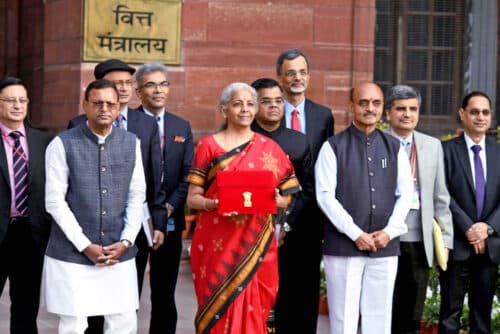Key features of Budget 2023-24 announced by Finance Minister Nirmala Sitharaman on
1st February this year are highlighted below, along with the reactions from the industry

Presenting the Union Budget this year, when Finance Minister Nirmala Sitharaman announced the adoption of Saptarishi (seven priorities) to guide India through the Amrit Kaal, all of the electronics industry was hoping for a helping hand too. And why not? The electronics and tech markets are still reeling under the Covid-19 pandemic-induced downfall.
Hence, the government’s decision to eliminate import duty on the camera lens and components was taken in good stead, as it will benefit mobile phone manufacturers in India. Electronic Industries Association of India (ELCINA) believes that such exemption should be extended to all other electronic product segments that use camera modules and electronic components.
Highlights
But before going into the nitty-gritty of it, let’s come back to square one and look at the major points of the Economic Survey and Union Budget 2023-24, with an eye on the Electronics System Design & Manufacturing (ESDM) sector:
- Globally, India is the 5th largest economy, and its per capita income has increased by over 2x in the last five years to ₹197,000.
- The domestic electronics industry, as of FY20, is valued at US$118 billion. India aims to reach US$300 billion worth of electronics manufacturing and US$ 120 billion in exports by FY26.
- The major drivers of growth in this industry are mobile phones, consumer electronics, and industrial electronics. India has become the second-largest mobile phone manufacturer globally, with the production of handsets going up from 60 million units in FY15 to 310 million units in FY22.
- ₹350 billion priority capital has been assigned for clean energy transition. The minister announced an outlay of ₹197 billion for the recently launched National Green Hydrogen Mission, with a target of 500MMT (million metric tonnes) of green hydrogen by 2030.
- Transportation and logistics received a major push with an outlay of ₹2,400 billion for railways and announcements for 50 additional airports, helipads, water aero drones, etc.
| The announcement of three Centres of Artificial Intelligence and 100 labs for 5G apps to nurture R&D in India with the vision to Make AI in India and Make AI work for India will further strengthen India’s position vis-à-vis global counterparts, said S. Durgaprasad, Co-founder, Director, and Group CEO of Bahwan CyberTek, a global provider of digital transformation solutions. |
- Pushing for a reduced digital divide, labs for 5G applications, classrooms, precision farming, and healthcare applications will be set up, and the scope of Digilocker will be expanded.
- Receiving a significant fillip after the lockdown, phase 3 of E-courts projects is to be launched with an outlay of ₹70 billion.
- This year, three Centres of Excellence for AI, and other advanced emerging technologies will be set up.
- The Budget also touched upon the aspect of skill development in Industry 4.0, robotics, drones, and related industries.
- The government reduced the basic customs duty (BCD) on certain parts, such as camera lenses, while concessional duty will continue on lithium-ion cells for another year.
- Agriculture Accelerator fund to be set up for encouraging innovative startups to bring affordable rural ideas to fruition.
| As per Jyoti Pal, Associate Partner at Lakshmikumaran & Sridharan, “Some changes have been made in Tariff Heading 8524 of the Customs Tariff Act. Separate tariff items have been added for flat panel display modules for certain categories of ADPM (Computers), mobile phones, television sets/ LCDs, and residual categories for others. Tariff Heading 8517 has also been amended.” |
| Table 1 | |||
| CUSTOM DUTY ANNOUNCEMENTS FOR ESDM SECTOR | |||
| Item | Exist. BCD (%) |
Updated BCD (%) | Notif./Finance Bill Clause |
| Camera lens for camera module and Input/sub parts for lens of camera module (mobile phone) | 2.5 | Nil | Notification No. 6/2023, Serial No. 3 |
| Parts for manufacture of open cells of TV panels | 5 | Nil | Notification No. 2/2023, Serial No. 33 |
| Capital goods and machinery required for manufacture of lithium-ion cells for batteries used in electric vehicles | 7.5 | Nil | Notification No. 6/2023, Serial No. 2 |
| Palladium Tetra Amine Sulphate for manufacture of parts of connectors | 7.5 | Nil | Notification No. 6/2023, Serial No. 1 |
| Specified chemicals/items for manufacture of Pre-calcined Ferrite Powder | 7.5 | Nil | Notification No. 6/2023, Serial No. 17 |
Changes to be noted
- Substitution/Amendment in Tariff Heading 8517–Information Technology Agreement, 1996–motivated in Supporting Manufacturing of Electronics.
- Expansion in the scope of Tariff Heading 8524: Separate tariff items have been added for flat panel display modules for certain categories of ADPM, mobile phones, television sets/LCDs, and residual categories for others.
- The scope of exemption expanded to include capital goods used for manufacturing the batteries for electrically operated vehicles.
- Reduction in the customs duty rate on components used in the manufacture of open cell of TV panels.
- Reduction in effective customs duty on the camera lens and sub-parts/inputs used in the manufacture of mobile phone camera modules.
Positive steps
The industry associations have welcomed the following steps announced in the Budget:
- Removal of duty of camera lens of 2.75%
- Removal of duty on inputs to parts of connectors—palladium tetra amine sulphate
- Reduction of BCD on parts of the open cell of the TV panel from 5.5% to 2.75% (including SWS)
- Continuation of customs exemption notifications, which were facing the sunset on the 31st of March 2023, for another year
- Customs duty exemption for the import of machinery required for the manufacture of lithium-ion cells for batteries used in EVs
- Reduction of BCD on specific parts used in the manufacturing of television sets to 2.5%
- Reclassification in HS Codes 8517 and 8524 for flat panel display inputs
- Relief on customs duty on import of certain parts used in the manufacturing of mobile phones
- Rectification of inverted duty structure to encourage manufacturing of electric kitchen chimneys
| Pratik Kamdar, Co-founder of Neuron Energy, a player in the battery industry remarked: “The Customs Duty exemption on capital goods and machinery to manufacture lithium-ion will be a facilitator for the country to transition to sustainable and eco-friendly mobility. The exemption will have a domino effect on the overall sector with the over substantial decrease in the overall cost of the finished products, wherein the battery packs are likely to reduce by 5% coupled with lower initial investments. Additionally, the vehicle scrapping policy will also be beneficial if the old vehicles are replaced by electric vehicles. This will further aid in the country’s vision of mass EV adoption by 2030.” |
Gaps









